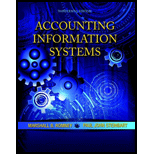
Identify the way in which the data differs from the information.
Answer to Problem 1CQ
Option (b)
Explanation of Solution
Option a: The data is the facts and the figures that become information once it is organised. Thus, in simple, the data is the input and information is the output. Hence, option (a) is not the correct answer.
Option b: The data are the input and the information is the output. This is because once the data are organized it forms the information. Thus, option (b) is the correct answer.
Option c: The data are not meaningful bits of information. The information is an organised and processed data provide the meaning. Thus, option (c) is not the correct answer.
Option d: The data are said to be unorganized facts and figures whereas the information is the organised facts and figures. Thus, there is a difference between the data and information. Hence, option (d) is not the correct answer.
Want to see more full solutions like this?
Chapter 1 Solutions
Accounting Information Systems (13th Edition)
- Can you solve this general accounting problem using appropriate accounting principles?arrow_forwardPlease explain the solution to this general accounting problem with accurate principles.arrow_forwardI am looking for a step-by-step explanation of this financial accounting problem with correct standards.arrow_forward
- I need help solving this general accounting question with the proper methodology.arrow_forwardReba Dixon is a fifth-grade school teacher who earned a salary of $37,080 in 2024. She is 45 years old and receives $1,200 of alimony payments each month from her former husband (divorced in 2016). Reba also rents out a small apartment building. This year Reba received $54,600 of rental payments from tenants, and she incurred $19,500 of expenses associated with the rental. Reba and her daughter Heather (20 years old at the end of the year) moved to Georgia in January of this year. Reba provides more than one-half of Heather's support. They had been living in Colorado for the past 15 years, but ever since her divorce, Reba has been wanting to move back to Georgia to be closer to her family. Luckily, last December, a teaching position opened up and Reba and Heather decided to make the move. Reba paid a moving company $2,470 to move their personal belongings, and she and Heather spent two days driving the 1,820 miles to Georgia. Reba rented a home in Georgia. Heather decided to continue…arrow_forwardBoston Industries completes job #842, which has a standard of 840 labor hours at a standard rate of $22.75 per hour. The job was completed in 890 hours, and the average actual labor rate was $23.10 per hour. What is the labor efficiency (quantity) variance? (A negative number indicates a favorable variance and a positive number indicates an unfavorable variance.)arrow_forward
- Please explain the solution to this general accounting problem with accurate principles.arrow_forwardI am looking for the correct answer to this general accounting question with appropriate explanations.arrow_forwardMonth Monthly Product Demand 2021-01-01 207.55 2021-02-01 208.25 2021-03-01 209.33 2021-04-01 210.11 2021-05-01 213.78 2021-06-01 225.12 2021-07-01 227.19 2021-08-01 218.92 2021-09-01 213.25 2021-10-01 210.75 2021-11-01 215.97 2021-12-01 223.97 2022-01-01 220.54 2022-02-01 213.47 2022-03-01 218.48 2022-04-01 222.07 2022-05-01 222.85 2022-06-01 236.38 2022-07-01 248.60 2022-08-01 234.45 2022-09-01 217.32 2022-10-01 222.56 2022-11-01 237.77 2022-12-01 245.59 2023-01-01 237.75 2023-02-01 213.70 2023-03-01 238.18 2023-04-01 244.78 2023-05-01 233.42 2023-06-01 241.35 2023-07-01 267.98 2023-08-01 249.97 2023-09-01 220.58 2023-10-01 233.12 2023-11-01 240.90 2023-12-01 268.61 2024-01-01 250.80 2024-02-01 225.31 2024-03-01 247.32 2024-04-01 248.50 2024-05-01 237.35 2024-06-01 258.62 2024-07-01 284.45 2024-08-01 256.21 2024-09-01 225.73 2024-10-01 234.07 2024-11-01 263.70 2024-12-01 286.03 Please…arrow_forward
- Accounting 12 May I please have a brief summary highlighting one unique feature of the app, recommending it to Sadie—who wants to use some apps for her dog grooming salon to schedule grooming appointments? Thank you so much,arrow_forwardGiven solution for General accounting question not use aiarrow_forwardKindly help me with this General accounting questions not use chart gpt please fast given solutionarrow_forward

 AccountingAccountingISBN:9781337272094Author:WARREN, Carl S., Reeve, James M., Duchac, Jonathan E.Publisher:Cengage Learning,
AccountingAccountingISBN:9781337272094Author:WARREN, Carl S., Reeve, James M., Duchac, Jonathan E.Publisher:Cengage Learning, Accounting Information SystemsAccountingISBN:9781337619202Author:Hall, James A.Publisher:Cengage Learning,
Accounting Information SystemsAccountingISBN:9781337619202Author:Hall, James A.Publisher:Cengage Learning, Horngren's Cost Accounting: A Managerial Emphasis...AccountingISBN:9780134475585Author:Srikant M. Datar, Madhav V. RajanPublisher:PEARSON
Horngren's Cost Accounting: A Managerial Emphasis...AccountingISBN:9780134475585Author:Srikant M. Datar, Madhav V. RajanPublisher:PEARSON Intermediate AccountingAccountingISBN:9781259722660Author:J. David Spiceland, Mark W. Nelson, Wayne M ThomasPublisher:McGraw-Hill Education
Intermediate AccountingAccountingISBN:9781259722660Author:J. David Spiceland, Mark W. Nelson, Wayne M ThomasPublisher:McGraw-Hill Education Financial and Managerial AccountingAccountingISBN:9781259726705Author:John J Wild, Ken W. Shaw, Barbara Chiappetta Fundamental Accounting PrinciplesPublisher:McGraw-Hill Education
Financial and Managerial AccountingAccountingISBN:9781259726705Author:John J Wild, Ken W. Shaw, Barbara Chiappetta Fundamental Accounting PrinciplesPublisher:McGraw-Hill Education





